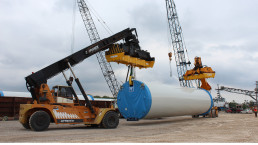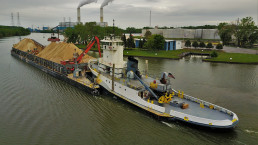Port welcomes largest project in history
Source: The Monroe News
The port will be called on 14 times for the project, handling about 560 wind tower segments in total.
Wind energy components are breezing through ports across the Great Lakes this shipping season.
The trend is benefiting the Port of Monroe, which is in the midst of handling one of its largest cargo endeavors.
A partnership between the port, Monroe-based Ventower Industries — a company that specializes in fabricating wind turbine towers — and Spliethoff Group’s BigLift Shipping is supporting General Electric’s wind energy efforts in the state.
Every eight days, the port handles a shipment of forty wind tower segments, according to Port Director Paul LaMarre III.
“The port has come a long way,” LaMarre said. “We have become a congregation and distribution hub for wind tower segments … It is the largest project in our history.”
The shipments, which take off from Becancour, Quebec, traverse the St. Lawrence Sea, the 2,300-mile marine highway that connects the Atlantic Ocean to the Great Lakes. They are being handled by the M/V Happy River, a BigLift ship.
The port will be called on 14 times for the project, handling about 560 wind tower segments in total.
“It comes down to relationships,” LaMarre said. “If you build relationships, the cargo will come.”
General Electric has a partnership with Ventower, which has produced several wind energy components for the company, according to LaMarre. Ventower has long used the port to move its products, he added.
That relationship drew the attention of General Electric, which saw the port’s logistics capabilities as advantageous, LaMarre said.
“At a time when other great lakes port are struggling to find any cargo, the relationships and business the port has built will ultimately provide to our sustainability,” he said.
The project is particularly important to the port due to a slow start to the shipping season, which usually begins in March.
COVID-19 had an impact on the port, LaMarre said, adding that cargo was scarce during the early days of the pandemic.
Limestone and coal account for a large part of the port’s business. There was less of a demand for the two as heavy industry and businesses were closed or restricted in an effort to slow the spread of the virus.
DTE Energy’s Monroe Power Plant also was impacted, LaMarre said. The utility generates a lot of business for the port, he added.
“When industry is nonoperational, little electricity is being used,” LaMarre said. “Humanity by itself doesn’t place place as much demand on the electrical grid as heavy industry does.”
For the first two months of the season, the port had no cargo to handle. It started receiving shipments in early May and coal shipments to the power plant have returned to a near-weekly basis, according to LaMarre.
The size and weight of the wind tower segments will help keep the port on track to beat its tonnage from last season, LaMarre said. Last month the port received a Pacesetter Award, which is given to ports that annually increase their handling of international shipping tonnage.
The pandemic also has changed operations at the port, which is taking extra precautions, LaMarre said. No COVID cases have been reported to the agency, he added.
All workers wear masks when on the dock. Port workers also stay on the dock when handling cargo while workers on vessels remain on their ships.
“It’s been challenging, to say the least,” LaMarre said. ”… we continue to count our blessings every day. Without this project this year, we would be facing significant challenges.”
St. Lawrence Seaway active with international shipments, moving global supply chain
American ports in the Great Lakes-St. Lawrence Seaway system record particularly noteworthy increases in project cargo as they advance the global supply chain, trading with 22 countries during the first two months of the navigation season. Year-to-date total tonnage—from the opening of the St. Lawrence Seaway on April 1, 2020 through May 31, 2020—is situated at 7.7 million metric tons (mt), down 10.2 percent compared to this time last year.
“In times like these, it is reassuring to see our ports in the Great Lakes St. Lawrence Seaway System working hard to keep the supply chain moving. The Great Lakes Seaway marine transportation system is critical infrastructure, and remains vital to keeping commerce flowing without disruption in order to support North America’s agricultural, manufacturing, construction, energy, and mining industries,” said Craig H. Middlebrook, Deputy Administrator of the U.S. Saint Lawrence Seaway Development Corporation.
Wind Energy Components Soaring at American Great Lakes Ports
With an increased focus on commodity diversification through project cargo, international shipments of wind energy components in the Great Lakes region are taking off. During the first two months of the 2020 navigation season, shiploads of wind-related components were handled across five Great Lakes states at eight American ports, including: Port of Monroe, Port of Erie, Port of Buffalo, Port of Ogdensburg, Port of Bay City, Port of Menominee, Port of Indiana-Burns Harbor and Port of Chicago.
Attracting new business through wind-related cargos and Seaway activity, both Port of Monroe and Port of Buffalo are benefiting from notable increases in shipping traffic.
“If there was a single word to describe the Port of Monroe, it would be resilient,” said Paul C. LaMarre III, Port Director, Port of Monroe. “Everything we have done puts relationships and the broader industry as a whole first. I believe, if you build the relationships, the cargo will follow it.”
Of these relationships, this navigation season brings to light a particularly impactful partnership between the Port of Monroe, Spliethoff Group’s BigLift Shipping, and Ventower Industry—one of four wind tower manufacturers in the United States—all working together to move, handle and manufacture wind towers for a General Electric project based in Michigan.
The Port of Monroe, serving the project as an advantageous congregation point for high value wind components coming by rail and vessel, now welcomes BigLift’s M/V Happy River on a nonstop shuttle delivering wind tower sections manufactured in Bécancour, Quebec every eight days.
In addition to logistical advantages due to the Port’s geographical location, BigLift’s vessels are particularly well suited for the Port of Monroe due to their size and the Port’s draft restrictions. To date, the M/V Happy River completed three voyages to Monroe—with eleven more planned—carrying forty wind tower sections per trip.
“The wind project and the tower sections are the lifeblood of our port this season,” said LaMarre. “Not only is this project impactful from the number of vessel calls, which will be the highest in our history for Seaway cargo, it’s with a partner that we’ve been in the trenches with for five years, has the majority of the Port’s laydown area being utilized, is using multiple modes of transportation, and sustaining our port workforce and partners in challenging times.”
Similarly, the Port of Buffalo is off to a strong start, filling their docks a total of thirty-two days since their navigation season began on April 12, 2020. To date, the Port of Buffalo welcomed three Seaway shipments of wind turbine components—two from Germany and one from Korea—and are expecting two more in the coming week.
“To the Port of Buffalo, handling these wind turbines means a full dock for the season. Not only are we unloading the vessels, but we’re also loading the trucks that take them to site. So, this is an opportunity to keep us busy all the way into fall,” said Patricia C. Schreiber, Port Director, Port of Buffalo.
Seaway ports see cargo volumes set for rebound
Source: MarineLog
While St. Lawrence Seaway cargo volumes decreased during the past two months due to economic shifts related to COVID-19, the Chamber of Marine Commerce reports industry leaders as saying that the Seaway is ready to play its part in the economic recovery efforts in the coming months.
Overall, St. Lawrence Seaway tonnage from March 15 through May 31 totaled 7.7 million metric tons, down 10% compared to the same time period in 2019. Road salt and project cargo shipments such as wind turbine components have remained strong throughout the last two months. However, cargo volumes of steel-related materials, construction materials, and petroleum declined.
“Great Lakes-Seaway shipping has continued to get the job done during these challenging times, safely delivering vital grain, renewable energy supplies and manufacturing inputs for domestic needs and world markets,” says Bruce Burrows, president of the Chamber of Marine Commerce. “Ship operators, ports, suppliers and the Seaway operators have really pulled together to put protective measures in place for our workers and the public and to ensure our transportation system has continued to operate throughout the pandemic without interruption or delay for our customers. Moving forward, Great Lakes-St. Lawrence Seaway shipping is ready to support ongoing efforts to restart the U.S. economy.”
DRY BULK DOWN, GENERAL CARGO UP
Dry bulk cargo shipments on the Seaway were down 5%. However, one of the first areas of improvement expected in cargo volumes are construction materials as pandemic-related restrictions continue to be lifted.
Year-to-date general cargo shipments via the St. Lawrence Seaway, including project cargo like wind turbine components and aluminum, were up 3.5%.
The Ports of Indiana-Burns Harbor has received 15 shipments of wind turbine components over the last two months. “We expect at least 10 more shipments of U.S.-built wind tower sections moving by deck barge from Manitowoc, Wis., down to Burns Harbor. These will be coupled with nacelles, hubs and blades being produced in Europe that are arriving into Burns Harbor via the Seaway,” says Ian Hirt, Port Director for the Ports of Indiana-Burns Harbor. “We are also expecting several vessels containing components for gas-powered electrical generation stations that are being constructed in the area. These are emblematic of a shift in energy production in the region away from coal-powered electricity.”
Tonnage at the Port of Toledo was down 12% in May compared to May 2019 which is attributed to COVID-19, flooding and poor grain harvest last fall.
“Our grain shipments are down significantly, but we’re hoping a good 2020 harvest will help us make up for some of the loss at the end of the season,” says Joseph Cappel, vice president of business development for the Toledo-Lucas County Port Authority. “The COVID-19 pandemic dramatically impacted construction and manufacturing and the associated demand for raw material and petroleum products. We expect that as the economy continues to recover, the recovery will be reflected in our tonnage numbers.”
The bright spot for Toledo in May was general cargo, which is up over 225% from last year. “We have handled a tremendous amount of aluminum at the general cargo facility so far in 2020,” says Cappel. “Smelters continue to produce aluminum and the Port of Toledo is a strategic location where metals can be stored and rapidly deployed into the marketplace when conditions are right.”
At the Port of Duluth-Superior, general cargo and grain had strong showings, but other tonnage categories were impacted by the pandemic.
“May was an especially difficult month in the Port of Duluth-Superior, with effects of the coronavirus slowing the tonnage pace in each major cargo category,” says Deb DeLuca, executive director of the Duluth Seaway Port Authority. “Through May 31, total tonnage trailed the 2019 pace by 28.5%, led by a sharp decline in coal tonnage due primarily to diminished demand from power plants on the lower Great Lakes. Iron ore, the port’s perennial tonnage leader, also slipped in May, ended the month 6% behind last season’s pace.
On a brighter note, grain tonnage finished May almost 26% ahead of the 2019 pace and 39% ahead of the five-season average. General cargo tonnage also registered an increase, closing the month approximately 9% ahead of last season and 11.5% above the five-season average.”
TRADE WITH 22 COUNTRIES
The U.S. Saint Lawrence Seaway Development Corporation said that U.S. Seaway ports traded with 22 countries during the first two months of the navigation season, recording particularly noteworthy increases in project cargo, even though overall tonnage was down 10.2% compared to this time last year.
“In times like these, it is reassuring to see our ports in the Great Lakes St. Lawrence Seaway System working hard to keep the supply chain moving. The Great Lakes Seaway marine transportation system is critical infrastructure, and remains vital to keeping commerce flowing without disruption in order to support North America’s agricultural, manufacturing, construction, energy, and mining industries,” said Craig H. Middlebrook, deputy administrator of the U.S. Saint Lawrence Seaway Development Corporation.
WIND ENERGY COMPONENTS SOARING
With an increased focus on commodity diversification through project cargo, international shipments of wind energy components in the Great Lakes region are taking off. During the first two months of the 2020 navigation season, shiploads of wind-related components were handled across five Great Lakes states at eight American ports, including: Port of Monroe, Port of Erie, Port of Buffalo, Port of Ogdensburg, Port of Bay City, Port of Menominee, Port of Indiana-Burns Harbor and Port of Chicago.
Attracting new business through wind-related cargos and Seaway activity, both Port of Monroe and Port of Buffalo are benefiting from notable increases in shipping traffic.
“If there was a single word to describe the Port of Monroe, it would be resilient,” said Paul C. LaMarre III, Port Director, Port of Monroe. “Everything we have done puts relationships and the broader industry as a whole first. I believe, if you build the relationships, the cargo will follow it.”
Of these relationships, this navigation season brings to light a particularly impactful partnership between the Port of Monroe, Spliethoff Group’s BigLift Shipping, and Ventower Industry—one of four wind tower manufacturers in the United States—all working together to move, handle and manufacture wind towers for a General Electric project based in Michigan.
The Port of Monroe now welcomes BigLift’s M/V Happy River on a nonstop shuttle delivering wind tower sections manufactured in Bécancour, Quebec every eight days. To date, the M/V Happy River has completed three voyages to Monroe—with eleven more planned—carrying forty wind tower sections per trip.
“The wind project and the tower sections are the lifeblood of our port this season,” said LaMarre.
Similarly, the Port of Buffalo is off to a strong start, filling its docks a total of 32 days since its navigation season began on April 12. To date, the port has welcomed three Seaway shipments of wind turbine components—two from Germany and one from Korea—and is expecting two more in the coming week.
The Three-peat Port: The Biggest Little Port
The Three-peat Port: The Biggest Little Port
Port of Monroe Wins Pacesetter Award in 2018, 2019 & Now 2020
Monroe, MI. (June 8, 2021) – The Port of Monroe navigates the 2021 Great Lakes-St. Lawrence Seaway Navigation Season with accolades and momentum from 2020.
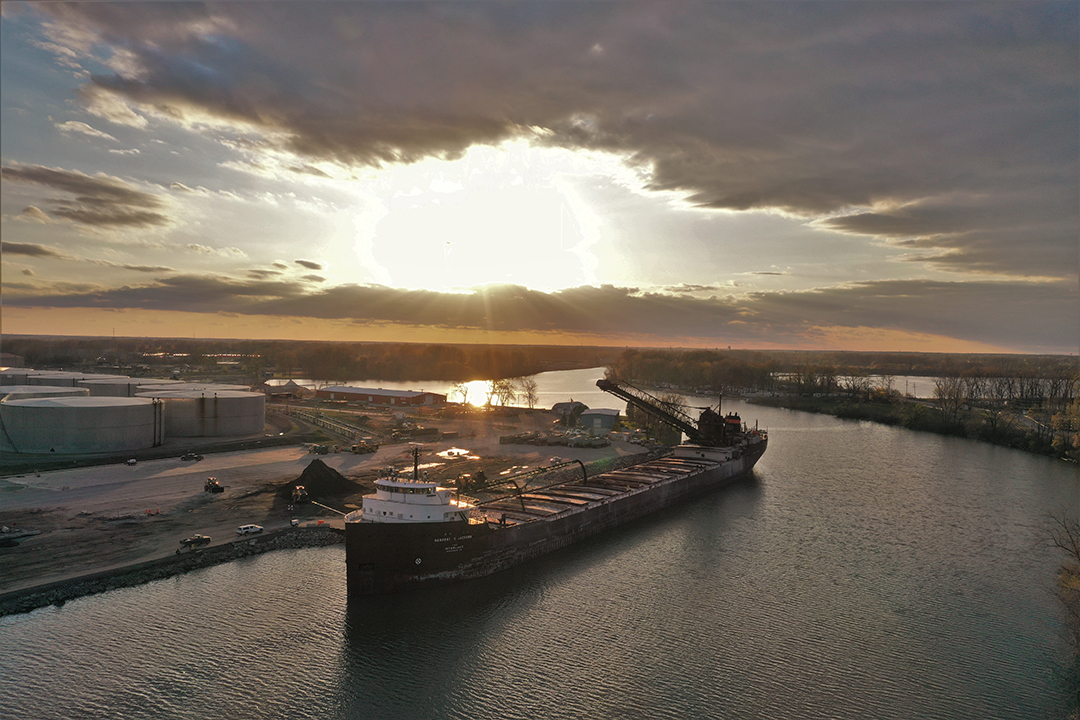
Accolades for the Biggest Little Port
The Great Lakes St. Lawrence Seaway Development Corporation (GLS), an agency of the U.S. Department of Transportation, recently awarded the Port of Monroe a 2020 navigation season Robert J. Lewis Pacesetter Award, which recognizes their efforts in increasing international Seaway cargo during the 2020 navigation season. The Port of Monroe received the Pacesetter Award six times out of the last eight seasons beginning in 2012, with consecutive awards in 2018, 2019 and 2020.
“The 2020 Pacesetter Award is truly a testament to the Port of Monroe’s resilience. We’re exceptionally proud to receive the Pacesetter Award because it is symbolic of the work ethic and professionalism of the men and women that support the biggest little port. It is also a testament to the hard work and resilience of everyone at the Port, I’m proud of them, especially after persevering through the past 18 months of the global coronavirus pandemic.” said Paul C. LaMarre III, director of the Port of Monroe
“Congratulations to the Port of Monroe for its third consecutive Pacesetter Award,” said GLS Deputy Administrator Craig H. Middlebrook. “The sustained level of high performance at the Port has positive economic implications for the City of Monroe, State of Michigan and maritime community across the system.” The Port of Monroe was one of only eight ports to receive the Pacesetter Award for the 2020 season.
From the 2018 Pacesetter Award Ceremony - Pictured Left to Right: Paul C. LaMarre III, Director, Port of Monroe; Dr. Arthur Sulzer, Founder, Maritime Academy Charter High School of Philadelphia & Advisory Board Member, Saint Lawrence Seaway Development Corporation; Craig H. Middlebrook, Deputy Administrator, Saint Lawrence Seaway Development Corporation.
As a testament to the Port’s continued success, the Port of Monroe is featured on the covers of two celebrated maritime publications, Know Your Ships 2021 and Greenwood’s Guide to Great Lakes Shipping 2021, as well as the cover of American Association of Port Authorities (AAPA) 2021 Seaports of the Americas Directory.
Established in 1992, the SLSDC Pacesetter Award recognizes U.S. ports who have registered increases in international cargo tonnage shipped through their ports and through the St. Lawrence Seaway.
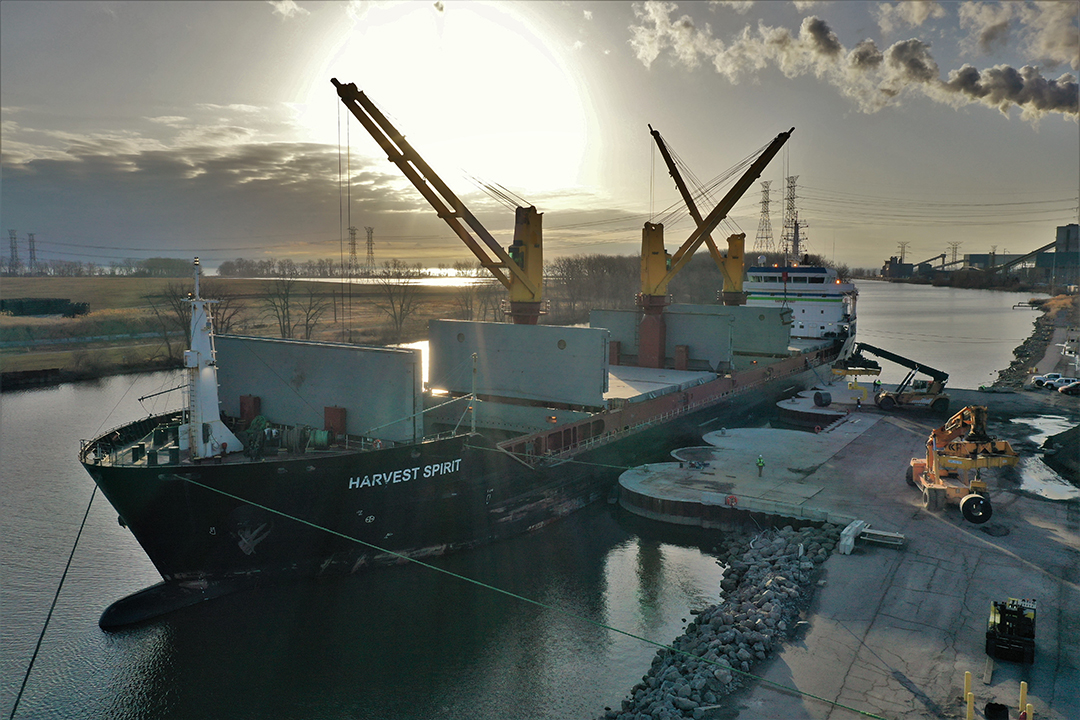
Cargo Moves
With consecutive Pacesetter awards in 2018, 2019 and 2020, the Port of Monroe is moving in the right direction. Milestones include:
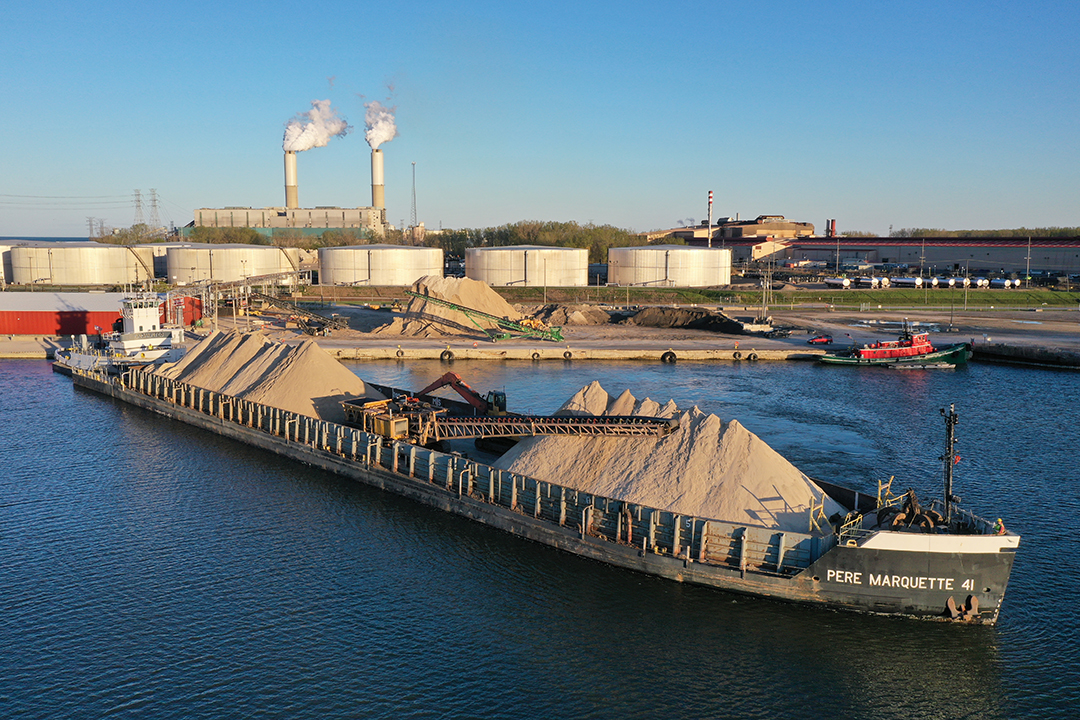
2018: Building Better Infrastructure
The 2018 season saw the first use of Port of Monroe’s new state funded Riverfront dock, which handled the first load of steel coils to Monroe and welcomed the liquid asphalt tanker IVER BRIGHT on her maiden voyage into the Great Lakes, carrying over 4,000 metric tons of liquid asphalt for Suncor.
2019: Moving the Largest International Shipment in the History of the Great Lakes-St. Lawrence Seaway System
The Port of Monroe’s noteworthy international inbound and outbound cargo handlings during the 2019 navigation season were crowned by a historic shipment. In October 2019, the Port of Monroe handled a generator stator for the Fermi II Nuclear Power Plant, which was the single most valuable piece of project cargo to ever move through the Seaway system. The Port also handled the original stator for the Fermi plant in 1976.
2020: Growing the Wind Energy Industry in America’s Heartland
In 2020, the port teamed up with Spliethoff Group’s BigLift Shipping and port tenant Ventower Industries to move, handle, and manufacture wind tower components for a large General Electric project. The heavy-lift vessel HAPPY RIVER was on a dedicated run between Monroe and Becancour, Quebec for most of the season delivering wind tower sections.
“2020 was one of the most prosperous navigation seasons in the port’s history,” said LaMarre. “That wasn’t the story that spanned the entire system, but one thing is for sure is that the Great Lakes-St. Lawrence Seaway system is resilient. Now we are in a position to increase shipments in 2021. The Port of Monroe handled around 1.4 million metric tons in 2020. With the momentum from 2020, activity at the port continued through the winter into 2021, and as the world opens up from the pandemic, we expect to surpass tonnage year-over-year in 2021.” said LaMarre.
2020: Cargo Diversification

2020: Top Performing Cargo
| Commodity | Tonnage (SHORT tons) |
| Coal & Petcoke | 938,229 |
| Limestone | 344,562 |
| Liquid Asphalt | 137,421 |
| Vessel/Bulk Product | 64,386 |
| Project Cargo | 43,404 |
About the Great Lakes Seaway Partnership
The Great Lakes Seaway Partnership is a coalition of leading US and Canadian maritime organizations working to enhance public understanding of the benefits of commercial shipping in the Great Lakes Seaway region of North America. The organization manages an education-focused communications program, sponsors research and works closely with media, policy makers, community groups, allied industries, environmental stakeholders and the general public to highlight the positive attributes of marine transportation.
The Great Lakes-St. Lawrence Seaway System is a marine highway that extends 2,300 miles from the Atlantic Ocean to the Great Lakes. Approximately 143.5 million metric tons of cargo is moved across the System on an annual basis, supporting more than 237,868 jobs and $35 billion in economic activity.
For more information, please visit http://www.greatlakesseaway.org.
###

